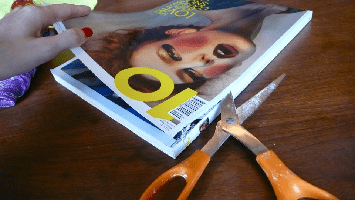“Fashion is not necessarily about labels. It’s not about brands. It’s about something else that comes from within you.”
—Ralph Lauren
When most people think about a fashion career, they picture a designer sketching an idea for a new dress, or a model walking down a runway to show off the latest design. While the fashion industry is incomplete without designers or models, there are also a number of other fashion careers that people might forget about. In fact, many of the fashion professionals who go unnoticed are the patternmakers, seamstresses, material sourcers, amongst many others. The designs that one sees on a regular basis are actually the product of a process that involves a number of different individuals with a variety of different skills. One should know a little more about the fashion industry in order to understand the careers one can pursue.
The fashion industry is attracting more probable employees than ever now. Thanks to Bollywood and Hollywood fashionistas, red carpet events and the explosion of media’s interests in fashion. It’s an industry that’s in high demand. However, it’s also a notoriously difficult industry to break into, so you have to make yourself stand out to be successful. For that, one has to have a stellar education and internships (even if you are just doing swatch libraries !!!) before stepping in the real world. Obviously, going to colleges for formal training won’t guarantee your dream job in fashion but education brings out the talent and sharpens the skills which are acquired through professional training and internships.
The fashion industry is typically split into four main fields: design, manufacturing, marketing/promotion, and retail sales. Careers include, modeling, photography, sales personnel, stylist, apparel, technical and accessory designing, pattern making, marketing ,retail management ,buyer, seamstress (tailor), visual merchandisers, journalist and many more.
In this article, we will be covering fashion and textile colleges in US and UK only, though one can study in many other places like Italy and France where knowledge of the Italian and French languages is helpful to go about.
Top Colleges in USA
New York / East Coast
- Pratt Institute, Brooklyn https://www.pratt.edu/academics/art_design/
- Parsons New School for Design, New York City https://www.newschool.edu/parsons/academics.aspx
- Fashion Institute of Technology ( FIT), New York City https://www.fitnyc.edu/
- Rhode Island School of Design, Providence https://www.risd.edu/
- Massachusetts College of Art and Design, Boston https://www.massart.edu/
- Maryland Institute College of Art,(MICA) Baltimore, https://www.mica.edu/Programs_of_Study.html
- Syracuse College, New York https://vpa.syr.edu/art-design
California / West Coast
- Academy of Art University( AAU), San Francisco https://www.academyart.edu/fashion-school/index.html
- California College of the Arts (CCA), San Francisco and Oakland https://www.cca.edu/academics
- Fashion Institute of Design and Merchandising (FIDM), Los Angeles, San Francisco, San Diego and Irvine https://fidm.edu/
- Otis College of Art and Design, Los Angeles https://www.otis.edu/
- University of California, Davis( UC Davis) https://admissions.ucdavis.edu/majors/major_view.cfm?major=atxc
Midwest
- Kent State University, Ohio https://www.kent.edu/artscollege/fashion/
- Cleveland Institute of Art, Ohio https://www.cia.edu/Majors_Fiber_and_Materials_Studies.aspx
- University of Cincinnati, Ohio https://www.artsci.uc.edu/
- School of the Art Institute of Chicago (SAIC) https://www.saic.edu/degrees_resources/departments/fash/index.html
- Savannah College of Art and Design in Savannah (SCAD), Georgia https://www.scad.edu/programs/fashion/index.cfm
Colleges in UK
- School of Fashion and design (SFD), London https://www.sfdlondon.com/
- Central Saint Martins College of art and design, London, https://www.csm.arts.ac.uk/
- Conde Nast International School of Fashion And Design (will open its doors in September 2012, by Vogue UK),
- The Arts University College at Bournemouth ( AUCB, south coast of England) https://aucb.ac.uk/courses/fashion-courses/all-courses
When one is trying to pick a college, one should not just stop at the top 10 or top 20 colleges. Besides college rankings, one needs to consider their own needs, career goals and optimal learning environment with opportunities. The points below should help:
- Courses: Colleges offer Associate degrees, certificate programs, undergraduate and graduate programs in various directions from trading, marketing, journalism, designing in basically everything (textile, apparel, accessory with further majors)– sky is the limit – study the programs and make your pick wisely). One should also make sure that the college is accredited.
- Location: Location is important when one is considering where to pursue their degree, but not necessarily because the college is in ‘the fashion capital’. Other metropolitan areas may offer local fashion industry opportunities, or have connections with the fashion world that enable you to meet top designers and apply for entry-level jobs and internships.
- Admission: Most basic requirements are multi –faceted portfolio (slide or CD format or as per college), TOEFL score, resume, recommendation letter from teacher or employer, official transcripts (attested mark sheets and/or degree), statement of intent, affidavit of support (for financial reasons), etc. More details would be available on the college websites.
- Cost: Generally fees vary from $ 20,000 to $ 40,000/ yr on college tuition fees alone, depending on the course. Supplies, living and food are extra expenses which one should account for. If one cannot afford the program outright, a good set of financial aid offerings may still make it possible to attend. Properly accredited institutions will enable you to take advantage of a wider range of financial aid options. However, financial aid is not available in private colleges.
Studying abroad is a challenge at first but then a delight. The teaching methods are very practical based than theory. Creativity is not bound and has no limits here since one can be very creative as one is not ‘told’ what to do, the way we are told in the Indian system. Classes have people of varied age groups, backgrounds and countries giving one an exciting holistic learning experience. The classes are smaller so the teachers can actually impart every individual his/her guidance and attention. Often classes do not fill a student’s entire day or week. In the free time, one can attend free classes on the campuses such that if one is lacking in some skills or wants to acquire new skills they can do so. One can also do on campus jobs to help them financially and learn the western way of working. There are also many campus events where one can participate which help in embracing the new life effortlessly.
Fashion and Textile jobs will continue to flourish as it is a growing field due to the consistent need for skilled and qualified professionals. Competition is fierce and will only intensify. Those who want to stand out must satisfy higher educational degrees and should possess originality, innovativeness and persistence. In all, a fashion or textile career isn’t for the faint of hearted. People in this field need to thrive in high-pressure environments. Those entering this occupation should be willing to work in a team, should be detail oriented with great organizational skills, work late unpredictable hours and work well under the demands of deadlines. They should also be able to handle criticism. Critics in this field can be brutal. Successful people know how to learn from a critique while maintaining their individual style. At the same time, it needs creativity, blend of fashion sense and business expertise, strategy and marketing know-how which are an integral part of this industry.
-Rajul J. Shah
MFA in Fashion Design, Academy of Art University, CA, USA
Worked in USA for 7 yrs







